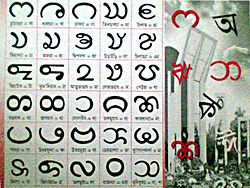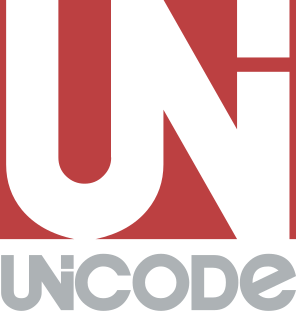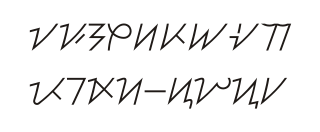Chakma is of the Brahmic type: the consonant letters contain an inherent vowel. Unusually for Brahmic scripts, the inherent vowel in Chakma is a long 'ā' (aː) as opposed to short 'a' (ə) which is standard in most other languages of India such as Hindi, Marathi or Tamil. Consonant clusters are written with conjunct characters, and a visible vowel killer shows the deletion of the inherent vowel when there is no conjunct.
Vowels
Four independent vowels exist: 𑄃 a, 𑄄 i, 𑄅 u, and 𑄆 e. Other vowels in initial position are formed by adding the vowel sign to 𑄃 a, as in 𑄃𑄩 ī, 𑄃𑄫 ū, 𑄃𑄭 ai, 𑄃𑄰 oi. Some modern writers are generalizing this spelling in 𑄃𑄨 i, 𑄃𑄪 u, and 𑄃𑄬 e.
Chakma vowel signs with the letter 𑄇ka are given below:
𑄇 Ka = 𑄇 Ka
𑄇𑄧 Ka = 𑄇 Kā + 𑄧 - a (11127)
𑄇𑄨 Ki = 𑄇 Kā + 𑄨 - i (11128)
𑄇𑄩 Kī = 𑄇 Kā + 𑄩 - ī (11129)
𑄇𑄪 Ku = 𑄇 Kā + 𑄪 - u (1112A)
𑄇𑄫 Kū = 𑄇 Kā + 𑄫 - ū (1112B)
𑄇𑄬 Ke = 𑄇 Kā + 𑄬 - e (1112C)
𑄇𑄭 Kāi = 𑄇 Kā + 𑄭 - āi (1112D)
𑄇𑄮 Ko = 𑄇 Kā + 𑄮 - o (1112E)
𑄇𑄯 Kau = 𑄇 Kā + 𑄯 - au (1112F)
𑄇𑄰 Koi = 𑄇 Kā + 𑄰 - oi (11130)
𑄇𑄀 Kaṃ = 𑄇 Kā + 𑄀 - ṃ (11100)
𑄇𑄁 Kaṃ = 𑄇 Kā + 𑄁 - ṃ (11101)
𑄇𑄂 Kaḥ = 𑄇 Kā + 𑄂 - ḥ (11102)
𑄇𑄴 K = 𑄇 Kā + 𑄴 - MAAYYAA (11134)
One of the interesting features of Chakma writing is that candrabindu (cānaphudā) can be used together with anusvara (ekaphudā) and visarga (dviphudā):
𑄃𑄂𑄀 Aḥṃ = 𑄃 ā + 𑄂 h + 𑄀ṃ
𑄃𑄁𑄀 Aṃṃ = 𑄃 ā + 𑄁 ṃ + 𑄀ṃ
𑄅𑄁𑄀 Uṃṃ = 𑄅 u + 𑄁 ṃ + 𑄀ṃ
𑄟𑄪𑄀 Muṃ = 𑄟 mā + 𑄪 u + 𑄀ṃ
Consonants with killed Vowels and Conjunct Consonants
Like other Brahmic scripts, Chakma makes use of the maayyaa (killer) to invoke conjoined consonants. In the past, practice was much more common than it is today. Like the Myanmar script, Chakma is encoded with two vowel-killing characters in order to conform to modern user expectations. As shown above, most letters have their vowels killed with the use of the explicit maayyaa:
𑄇𑄴 k = 𑄇 kā + 𑄴 MAAYYAA
In 2001 an orthographic reform was recommended in the book Cāṅmā pattham pāt which would limit the standard repertoire of conjuncts to those composed with the five letters 𑄠 yā, 𑄢 rā, 𑄣 lā, 𑄤 wā, and 𑄚 nā. The four here are the most widely accepted repertoire of conjuncts.
ya: X + 𑄳 VIRAMA + 𑄠 yā
𑄇𑄳𑄠 𑄈𑄳𑄠 𑄉𑄳𑄠 𑄊𑄳𑄠 𑄋𑄳𑄠 - 𑄌𑄳𑄠 𑄍𑄳𑄠 𑄎𑄳𑄠 𑄏𑄳𑄠 𑄐𑄳𑄠 - 𑄑𑄳𑄠 𑄒𑄳𑄠 𑄓𑄳𑄠 𑄔𑄳𑄠 𑄕𑄳𑄠
𑄖𑄳𑄠 𑄗𑄳𑄠 𑄘𑄳𑄠 𑄙𑄳𑄠 𑄚𑄳𑄠 - 𑄛𑄳𑄠 𑄜𑄳𑄠 𑄝𑄳𑄠 𑄞𑄳𑄠 𑄟𑄳𑄠 - 𑄦𑄳𑄠 𑄠𑄳𑄠 𑄡𑄳𑄠 𑄢𑄳𑄠 𑄤𑄳𑄠 𑄥𑄳𑄠
ra: X + 𑄳 VIRAMA + 𑄢 rā
𑄇𑄳𑄢 𑄈𑄳𑄢 𑄉𑄳𑄢 𑄊𑄳𑄢 𑄋𑄳𑄢 - 𑄌𑄳𑄢 𑄍𑄳𑄢 𑄎𑄳𑄢 𑄏𑄳𑄢 𑄐𑄳𑄢 - 𑄑𑄳𑄢 𑄒𑄳𑄢 𑄓𑄳𑄢 𑄔𑄳𑄢 𑄕𑄳𑄢
𑄖𑄳𑄢 𑄗𑄳𑄢 𑄘𑄳𑄢 𑄙𑄳𑄢 𑄚𑄳𑄢 - 𑄛𑄳𑄢 𑄜𑄳𑄢 𑄝𑄳𑄢 𑄞𑄳𑄢 𑄟𑄳𑄢 - 𑄦𑄳𑄢 𑄠𑄳𑄢 𑄡𑄳𑄢 𑄢𑄳𑄢 𑄤𑄳𑄢 𑄥𑄳𑄢
la: X + 𑄳 VIRAMA + 𑄣 lā
𑄇𑄳𑄣 𑄈𑄳𑄣 𑄉𑄳𑄣 𑄊𑄳𑄣 𑄋𑄳𑄣 - 𑄌𑄳𑄣 𑄍𑄳𑄣 𑄎𑄳𑄣 𑄏𑄳𑄣 𑄐𑄳𑄣 - 𑄑𑄳𑄣 𑄒𑄳𑄣 𑄓𑄳𑄣 𑄔𑄳𑄣 𑄕𑄳𑄣
𑄖𑄳𑄣 𑄗𑄳𑄣 𑄘𑄳𑄣 𑄙𑄳𑄣 𑄚𑄳𑄣 - 𑄛𑄳𑄣 𑄜𑄳𑄣 𑄝𑄳𑄣 𑄞𑄳𑄣 𑄟𑄳𑄣 - 𑄦𑄳𑄣 𑄠𑄳𑄣 𑄡𑄳𑄣 𑄢𑄳𑄣 𑄥𑄳𑄣
wa: X + 𑄳 VIRAMA + 𑄤 wā
𑄇𑄳𑄤 𑄈𑄳𑄤 𑄉𑄳𑄤 𑄊𑄳𑄤 𑄋𑄳𑄤 - 𑄌𑄳𑄤 𑄍𑄳𑄤 𑄎𑄳𑄤 𑄏𑄳𑄤 𑄐𑄳𑄤 - 𑄑𑄳𑄤 𑄒𑄳𑄤 𑄓𑄳𑄤 𑄔𑄳𑄤 𑄕𑄳𑄤
𑄖𑄳𑄤 𑄗𑄳𑄤 𑄘𑄳𑄤 𑄙𑄳𑄤 𑄚𑄳𑄤 - 𑄛𑄳𑄤 𑄜𑄳𑄤 𑄝𑄳𑄤 𑄞𑄳𑄤 𑄟𑄳𑄤 - 𑄦𑄳𑄤 𑄠𑄳𑄤 𑄡𑄳𑄤 𑄢𑄳𑄤 𑄥𑄳𑄤
No separate conjunct forms of subjoined full-form -yā or -rā appear to exist. The fifth of these conjuncts, the -na conjunct, is exemplary of the orthographic shift which has taken place in the Chakma language.
na: X + 𑄳 VIRAMA + 𑄚 nā
𑄇𑄳𑄚 𑄈𑄳𑄚 𑄉𑄳𑄚 𑄊𑄳𑄚 𑄋𑄳𑄚 - 𑄌𑄳𑄚 𑄍𑄳𑄚 𑄎𑄳𑄚 𑄏𑄳𑄚 𑄐𑄳𑄚 - 𑄑𑄳𑄚 𑄒𑄳𑄚 𑄓𑄳𑄚 𑄔𑄳𑄚 𑄕𑄳𑄚
𑄖𑄳𑄚 𑄗𑄳𑄚 𑄘𑄳𑄚 𑄙𑄳𑄚 𑄚𑄳𑄚 - 𑄛𑄳𑄚 𑄜𑄳𑄚 𑄝𑄳𑄚 𑄞𑄳𑄚 𑄟𑄳𑄚 - 𑄦𑄳𑄚 𑄠𑄳𑄚 𑄡𑄳𑄚 𑄢𑄳𑄚 𑄥𑄳𑄚
While some writers would indeed write kakna (in ligating style) as 𑄇𑄇𑄳𑄚 or (in subjoining style) as 𑄇𑄇𑄳𑄚, most now would probably expect it to be written as 𑄇𑄇𑄴𑄚. The ligating style of glyphs is now considered old-fashioned. Thus, taking the letter 𑄟 mā as the second element, while the glyph shapes 𑄇𑄳𑄟 kmā, 𑄖𑄳𑄟 tmā, 𑄚𑄳𑄟 nmā, 𑄝𑄳𑄝 bbā, 𑄟𑄳𑄟 mmā, 𑄣𑄳𑄣 llā, 𑄥𑄳𑄟 smā, and 𑄦𑄳𑄟 hmā are attested, most users now prefer the glyph shapes 𑄇𑄳𑄟 kmā, 𑄖𑄳𑄟 tmā, 𑄚𑄳𑄟 nmā, 𑄝𑄳𑄝 bbā, 𑄟𑄳𑄟 mmā, 𑄣𑄳𑄣 llā, 𑄥𑄳𑄟 smā, and 𑄦𑄳𑄟 hmā. Again, this distinction is stylistic and not orthographic.
The 2004 book Phadagaṅ shows examples of the five conjuncts above together alongside conjuncts formed with 𑄝 bā, 𑄟 mā, and 𑄦 hā. These are all formed by simple subjoining.
ba: X + 𑄳 VIRAMA + 𑄝 nā
𑄇𑄳𑄝 𑄈𑄳𑄝 𑄉𑄳𑄝 𑄊𑄳𑄝 𑄋𑄳𑄝 - 𑄌𑄳𑄝 𑄍𑄳𑄝 𑄎𑄳𑄝 𑄏𑄳𑄝 𑄐𑄳𑄌 - 𑄑𑄳𑄝 𑄒𑄳𑄝 𑄓𑄳𑄝 𑄔𑄳𑄚 𑄕𑄳𑄝
𑄖𑄳𑄝 𑄗𑄳𑄝 𑄘𑄳𑄝 𑄙𑄳𑄝 𑄚𑄳𑄚 - 𑄛𑄳𑄝 𑄜𑄳𑄝 𑄝𑄳𑄝 𑄞𑄳𑄝 𑄟𑄳𑄝 - 𑄠𑄳𑄝 𑄡𑄳𑄝 𑄢𑄳𑄝 𑄣𑄳𑄝 𑄤𑄳𑄝 𑄥𑄳𑄝
ma: X + 𑄳 VIRAMA + 𑄟 nā
𑄇𑄳𑄟 𑄈𑄳𑄟 𑄉𑄳𑄟 𑄊𑄳𑄟 𑄋𑄳𑄟 - 𑄌𑄳𑄟 𑄍𑄳𑄟 𑄎𑄳𑄟 𑄏𑄳𑄟 𑄐𑄳𑄟 - 𑄑𑄳𑄟 𑄒𑄳𑄟 𑄓𑄳𑄟 𑄔𑄳𑄟 𑄕𑄳𑄟
𑄖𑄳𑄟 𑄗𑄳𑄟 𑄘𑄳𑄟 𑄙𑄳𑄟 𑄚𑄳𑄟 - 𑄛𑄳𑄟 𑄜𑄳𑄟 𑄝𑄳𑄟 𑄞𑄳𑄟 𑄟𑄳𑄟 - 𑄠𑄳𑄟 𑄡𑄳𑄟 𑄢𑄳𑄟 𑄣𑄳𑄟 𑄤𑄳𑄟 𑄥𑄳𑄟
ha: X + 𑄳 VIRAMA + 𑄦 nā
𑄇𑄳𑄦 𑄈𑄳𑄦 𑄉𑄳𑄦 𑄊𑄳𑄦 𑄋𑄳𑄦 - 𑄌𑄳𑄦 𑄍𑄳𑄦 𑄎𑄳𑄦 𑄏𑄳𑄦 𑄐𑄳𑄦 - 𑄑𑄳𑄦 𑄒𑄳𑄦 𑄓𑄳𑄦 𑄔𑄳𑄦 𑄕𑄳𑄦
𑄖𑄳𑄦 𑄗𑄳𑄦 𑄘𑄳𑄦 𑄙𑄳𑄦 𑄚𑄳𑄦 - 𑄛𑄳𑄦 𑄜𑄳𑄦 𑄝𑄳𑄦 𑄞𑄳𑄦 𑄟𑄳𑄦 - 𑄠𑄳𑄦 𑄡𑄳𑄦 𑄢𑄳𑄦 𑄣𑄳𑄦 𑄤𑄳𑄦 𑄥𑄳𑄦
In the 1982 book Cāṅmār āg pudhi a much wider range of conjunct pairs is shown, some of them with fairly complicated glyphs:
𑄇𑄳𑄇 Kkā = 𑄇 Kā + 𑄳 VIRAMA + 𑄇 Kā
𑄇𑄳𑄑 Ktā = 𑄇 Kā + 𑄳 VIRAMA + 𑄑 Tā
𑄇𑄳𑄖 Ktā = 𑄇 Kā + 𑄳 VIRAMA + 𑄖 Tā
𑄇𑄳𑄟 Kmā = 𑄇 Kā + 𑄳 VIRAMA + 𑄟 Mā
𑄇𑄳𑄌 Kcā = 𑄇 Kā + 𑄳 VIRAMA + 𑄌 Cā
𑄋𑄳𑄇 ńkā = 𑄋 ńā + 𑄳 VIRAMA + 𑄇 Kā
𑄋𑄳𑄉 ńkā = 𑄋 ńā + 𑄳 VIRAMA + 𑄉 Gā
𑄌𑄳𑄌 ccā = 𑄌 cā + 𑄳 VIRAMA + 𑄌 Cā
𑄌𑄳𑄍 Cchā = 𑄌 Cā + 𑄳 VIRAMA + 𑄍 Chā
𑄐𑄳𑄌 ñcā = 𑄐 ñā + 𑄳 VIRAMA + 𑄌 Cā
𑄐𑄳𑄎 ñjā = 𑄐 ñā + 𑄳 VIRAMA + 𑄎 Jā
𑄐𑄳𑄏 Ñjhā = 𑄐 ñā + 𑄳 VIRAMA + 𑄏 Jhā
𑄑𑄳𑄑 Ttā = 𑄑 Tā + 𑄳 VIRAMA + 𑄑 Tā
𑄖𑄳𑄖 Ttā = 𑄖 Tā + 𑄳 VIRAMA + 𑄖 Tā
𑄖𑄳𑄟 Tmā = 𑄖 Tā + 𑄳 VIRAMA + 𑄟 mā
𑄖𑄳𑄗 Tthā = 𑄖 Tā + 𑄳 VIRAMA + 𑄗 Thā
𑄘𑄳𑄘 Ddā = 𑄘 Dā + 𑄳 VIRAMA + 𑄘 Dā
𑄘𑄳𑄙 Ddhā = 𑄘 Dā + 𑄳 VIRAMA + 𑄙 Dhā
𑄚𑄳𑄖 ntā = 𑄚 nā + 𑄳 VIRAMA + 𑄖 tā
𑄚𑄳𑄗 nthā = 𑄚 nā + 𑄳 VIRAMA + 𑄗 thā
𑄚𑄳𑄟 nmā = 𑄚 nā + 𑄳 VIRAMA + 𑄟 mā
𑄛𑄳𑄛 ppā = 𑄛 pā + 𑄳 VIRAMA + 𑄛 pā
𑄝𑄳𑄝 bbā = 𑄝 bā + 𑄳 VIRAMA + 𑄝 bā
𑄟𑄳𑄟 mmā = 𑄟 mā + 𑄳 VIRAMA + 𑄟 mā
𑄎𑄳𑄎 jjā = 𑄎 jā + 𑄳 VIRAMA + 𑄎 jā
𑄣𑄳𑄇 lkā = 𑄣 lā + 𑄳 VIRAMA + 𑄇 kā
𑄣𑄳𑄉 lgā = 𑄣 lā + 𑄳 VIRAMA + 𑄉 gā
𑄣𑄳𑄣 llā = 𑄣 lā + 𑄳 VIRAMA + 𑄣 lā
𑄣𑄳𑄑 ltā = 𑄣 lā + 𑄳 VIRAMA + 𑄑 tā
𑄣𑄳𑄛 lpā = 𑄣 lā + 𑄳 VIRAMA + 𑄛 pā
𑄣𑄳𑄍 lchā = 𑄣 lā + 𑄳 VIRAMA + 𑄍 chā
𑄥𑄳𑄑 stā = 𑄥 sā + 𑄳 VIRAMA + 𑄑 tā
𑄥𑄳𑄇 skā = 𑄥 sā + 𑄳 VIRAMA + 𑄇 kā
𑄥𑄳𑄛 spā = 𑄥 sā + 𑄳 VIRAMA + 𑄛 pā
𑄥𑄳𑄟 smā = 𑄥 sā + 𑄳 VIRAMA + 𑄟 mā
𑄦𑄳𑄟 hmā = 𑄦 hā + 𑄳 VIRAMA + 𑄟 hmā















